Planning & Engineering often go together like cats and dogs, conservatives and liberals, or oil and water. This series of educational articles that will teach you about new opportunities for engineers who embrace planning – a new era of preferred living standards called, Prefurbia.
Providing for Surface Drainage through more efficient planning:
Planning and engineering merge when creating ‘green’ solutions, including proven methods such as surface storm water flow (that is also affordable compared to piped flow).
Nature has provided land with flow that has evolved over time. However, typical urban and suburban development patterns destroy millions of years of evolution. It’s most efficient to keep surface flow as close to the natural system as possible – the best solution from both economic and environmental perspectives.
Trying to force a square peg in a round hole:
A conventionally designed subdivision or a “Smart Growth” grid (as seen in this picture) is often unnatural because contour lines don’t naturally form a grid. For natural surface flow to replace piped storm sewers, you need two things – following the existing downhill direction, which is unlikely to favor a grid development – and plenty of space.
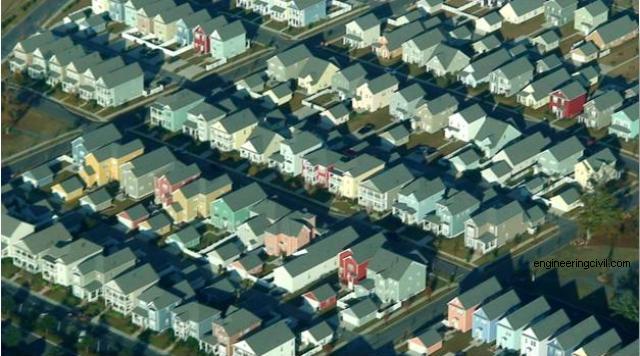
So how do grid designs get the necessary space to maintain natural surface drainage?
By removing lots and lots of ‘lots’. A grid-platted site with surface flow will lose considerable density in creating the space required for water courses. This results in reducing the development’s profit, unless space is already committed for open space, flood limits, etc.
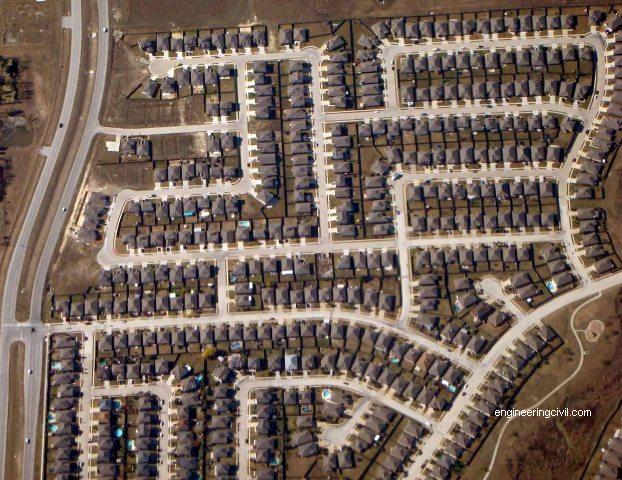
What makes subdivisions so rigid?
Typical subdivision designers use the CAD software “offset” command which automatically generates parallel lines, to quickly create rows of rectangular design lots that likely conflicts with natural surface flow. This easy design method is apparent in the above south Ft. Worth, Texas development, an area where land is naturally rolling.
The result disturbs the flow that nature has taken a millennium to create and but a few minutes in CAD to destroy.
A New Foundation
What if a new design could provide space for surface flow, without losing density? How about providing the space, maintaining density and actually increasing the average lot size, all while meeting the municipal minimums?
Prefurbia – An organic design solution.
Coving was the first non-rigid planning method (street and house patterns course independently) introduced and is one of the cornerstones for Prefurbia’s new geometry. A coved design reduces the street length required for development, typically 25%, while preserving density, compared to a conventional design using the same set of regulations. Reducing street while maintaining the same number of lots, means that Coving provides far more green space than paved space. Coving becomes an excellent foundation for natural surface flow. A coved design can become more efficient as shapes become more ‘fluid’, emulating nature.
Below is a conventionally planned single family subdivision that also seems to maximize it’s land use. An area to the north on the site is reserved for detention ponds. This is an approved plat ready to be developed, however, it was found that the detention area on the upper portion of the plan was not sufficient. About this same time of delay to approvals because of the detention, then the developer was made aware of Prefurbia. This particular municipality requires a 4’ wide walk constructed both sides of the street indicated by the white lines parallel to the paving.
This plan seems to be very efficient by religiously following the minimums. The plan fills up available space with very little organic area left over. There is no room for surface flow solutions.
Using new technologies that track design induced waste we can determine the efficiency of a plan. Think of this as having the EPA mileage listed on a car window, or the HERS rating of a home to measure efficiency. For land plans this is called Environmental/Economic Density, or the ED Ratio.
Now let’s look at the ED Chart of the above layout:
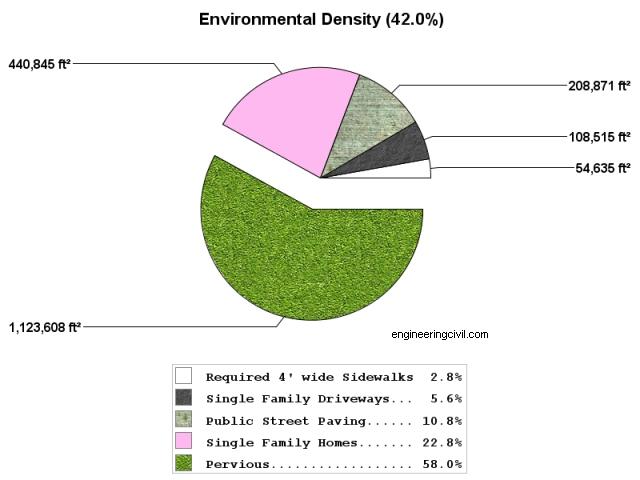
The total percentage of man made “stuff” on this site is 48.3%, with the large green area representing remaining surface that is organic. The environmental density of the single family subdivision is just 42% so surely that would indicate an efficient design. However, there is little left over green space around the residences with families that overlook each other’s bedroom windows.
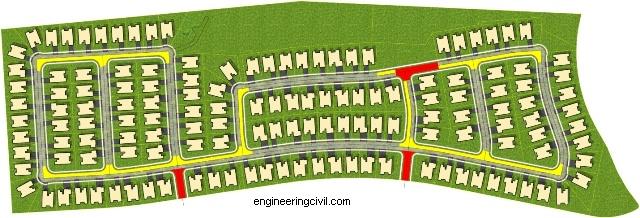
Of the 208,871 square feet of street paving, 55,932 square feet (yellow) is half utilized, and 13,760 square feet (red) is 100% waste. This equates into exactly 1/3rd of the street is being built is waste – what appears to be efficient is not! The 7,461 linear feet of street, priced approximately $300 a foot will cost the developer $2,238,300 to construct. Four foot wide sidewalks add up to 13,659 linear feet (2.6 miles) which are not likely to be used much because 4’ wide simply is not enough for a couple to walk side by side. Narrow walks discourages a stroll which encourages driving or worse, strolling on the streets!
It’s impossible to create a plan with zero waste, however, we can do a much better job of reducing it. The science of reducing waste has not been part of education or awareness in land planning. The new era of Prefurbia design requires a significant reduction in waste. We need to train future planners and engineers to recognize and eliminating as much waste as possible.
This exciting and efficient plan adds functionality of a beautiful 6 foot wide (50% wider than the original) meandering walkways that invite a stroll. The 41,028 square feet of walks has 25% less surface area reducing costs and environmental impacts. There is 4,974 linear feet of street, again reducing environmental impacts and cost to construct (and maintain) by a third!
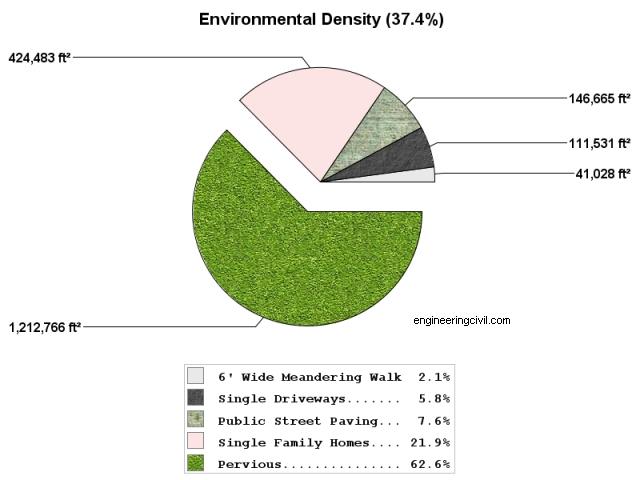
The ED Ratio drops from 42.0 to 37.4 (11%) with a slight loss of density (141 to 136 or -4%). The space, livability, curb appeal, value, functionality and connectivity of Prefurbia is superior to the original conventional subdivision. The darker green areas behind the lots represent plantings that are low maintenance with space to eliminate much of the storm sewer pipes.
Environmentally and economically sound
By increasing green space, there’s space for the conduit for storm water surface flow and shorter runs for underground sanitary sewer and water mains. Eliminating, or at a worse case, reducing, sewer pipe decreases construction costs. Surface storm water systems are certainly not “free” and when landscaped as an amenity, can add significant costs. However, the construction costs will be below that of piped storm sewer.
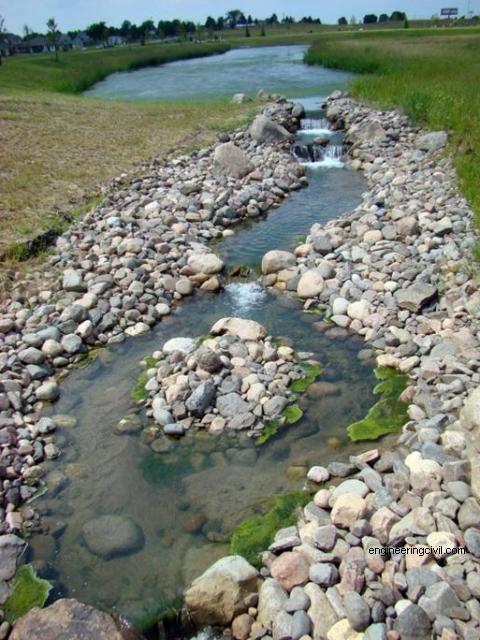
A well done and beautifully landscaped surface flow system should still be more economical than the conventional storm drain inlets, manholes and pipe. An attractive landscaped surface flow system does something that an underground pipe can never do – increase curb appeal. A few years ago that would have translated into home premiums; today, it may be just the difference in selling homes at all. Going ‘green’ on sales literature, will certainly help leverage a neighborhood over the conventional developments nearby.
We are thankful to Sir Richard Harrison for submitting this very useful information to us.
If you have a query, you can ask a question here.


